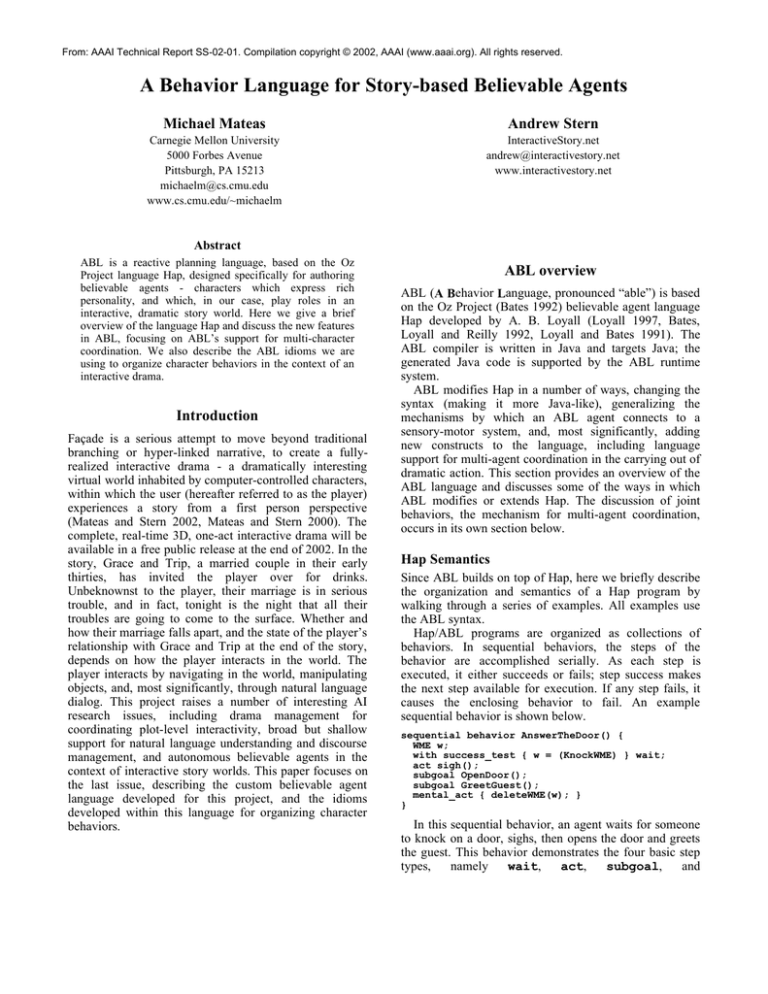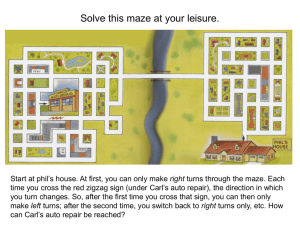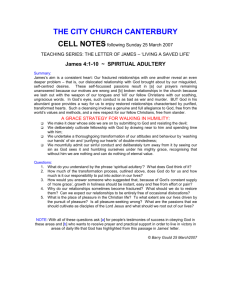
From: AAAI Technical Report SS-02-01. Compilation copyright © 2002, AAAI (www.aaai.org). All rights reserved.
A Behavior Language for Story-based Believable Agents
Michael Mateas
Andrew Stern
Carnegie Mellon University
5000 Forbes Avenue
Pittsburgh, PA 15213
michaelm@cs.cmu.edu
www.cs.cmu.edu/~michaelm
InteractiveStory.net
andrew@interactivestory.net
www.interactivestory.net
Abstract
ABL is a reactive planning language, based on the Oz
Project language Hap, designed specifically for authoring
believable agents - characters which express rich
personality, and which, in our case, play roles in an
interactive, dramatic story world. Here we give a brief
overview of the language Hap and discuss the new features
in ABL, focusing on ABL’s support for multi-character
coordination. We also describe the ABL idioms we are
using to organize character behaviors in the context of an
interactive drama.
Introduction
Façade is a serious attempt to move beyond traditional
branching or hyper-linked narrative, to create a fullyrealized interactive drama - a dramatically interesting
virtual world inhabited by computer-controlled characters,
within which the user (hereafter referred to as the player)
experiences a story from a first person perspective
(Mateas and Stern 2002, Mateas and Stern 2000). The
complete, real-time 3D, one-act interactive drama will be
available in a free public release at the end of 2002. In the
story, Grace and Trip, a married couple in their early
thirties, has invited the player over for drinks.
Unbeknownst to the player, their marriage is in serious
trouble, and in fact, tonight is the night that all their
troubles are going to come to the surface. Whether and
how their marriage falls apart, and the state of the player’s
relationship with Grace and Trip at the end of the story,
depends on how the player interacts in the world. The
player interacts by navigating in the world, manipulating
objects, and, most significantly, through natural language
dialog. This project raises a number of interesting AI
research issues, including drama management for
coordinating plot-level interactivity, broad but shallow
support for natural language understanding and discourse
management, and autonomous believable agents in the
context of interactive story worlds. This paper focuses on
the last issue, describing the custom believable agent
language developed for this project, and the idioms
developed within this language for organizing character
behaviors.
ABL overview
ABL (A Behavior Language, pronounced “able”) is based
on the Oz Project (Bates 1992) believable agent language
Hap developed by A. B. Loyall (Loyall 1997, Bates,
Loyall and Reilly 1992, Loyall and Bates 1991). The
ABL compiler is written in Java and targets Java; the
generated Java code is supported by the ABL runtime
system.
ABL modifies Hap in a number of ways, changing the
syntax (making it more Java-like), generalizing the
mechanisms by which an ABL agent connects to a
sensory-motor system, and, most significantly, adding
new constructs to the language, including language
support for multi-agent coordination in the carrying out of
dramatic action. This section provides an overview of the
ABL language and discusses some of the ways in which
ABL modifies or extends Hap. The discussion of joint
behaviors, the mechanism for multi-agent coordination,
occurs in its own section below.
Hap Semantics
Since ABL builds on top of Hap, here we briefly describe
the organization and semantics of a Hap program by
walking through a series of examples. All examples use
the ABL syntax.
Hap/ABL programs are organized as collections of
behaviors. In sequential behaviors, the steps of the
behavior are accomplished serially. As each step is
executed, it either succeeds or fails; step success makes
the next step available for execution. If any step fails, it
causes the enclosing behavior to fail. An example
sequential behavior is shown below.
sequential behavior AnswerTheDoor() {
WME w;
with success_test { w = (KnockWME) } wait;
act sigh();
subgoal OpenDoor();
subgoal GreetGuest();
mental_act { deleteWME(w); }
}
In this sequential behavior, an agent waits for someone
to knock on a door, sighs, then opens the door and greets
the guest. This behavior demonstrates the four basic step
wait,
act,
subgoal,
types,
namely
and
mental_act. Wait steps are never chosen for execution;
a naked wait step in a sequential behavior would block the
behavior from executing past the wait. However, when
combined with a success test, a wait step can be used to
make a demon which waits for a condition to become
true. Success tests are continuously monitored conditions
which, when they become true, cause their associated step
to immediately succeed. Though in this example the
success test is associated with a wait step to make a
demon, it can be associated with any step type.
Success tests, as well as other tests which will be
described shortly, perform their test against the agent’s
working memory. A working memory contains a number
of working memory elements (WMEs) which hold
information. WMEs are like classes in an object oriented
language; every WME has a type plus some number of
typed fields which can take on values. As described later
on in the paper, WMEs are also the mechanism by which
an agent becomes aware of sensed information. In this
example, the success test is looking for WMEs of type
KnockWME, which presumably is placed in the agent’s
working memory when someone knocks on a door. Since
there are no field constraints in the test, the test succeeds
as soon as a KnockWME appears.
An act step tells the agent’s body (sensory-motor
system) to perform an action. For graphical environments
such as Façade, physical acts will ultimately be translated
into calls to the animation engine, though the details of
this translation are hidden from the Hap/ABL program. In
this example, the act makes the body sigh. Note that
physical acts can fail - if the sensory-motor system
determines that it is unable to carry out the action, the
corresponding act step fails, causing the enclosing
behavior to fail.
Subgoal steps establish goals that must be
accomplished in order to accomplish the behavior. The
pursuit of a subgoal within a behavior recursively results
in the selection of a behavior to accomplish the subgoal.
Mental acts are used to perform bits of pure
computation, such as mathematical computations or
modifications to working memory. In the final step of the
example, the mental_act deletes the KnockWME (making
a call to a method defined on ABL agent), since the
knocking has now been dealt with. In ABL, mental acts
are written in Java.
The next example demonstrates how Hap/ABL selects
a behavior to accomplish a subgoal through signature
matching and precondition satisfaction.
sequential behavior OpenDoor() {
precondition {
(KnockWME doorID :: door)
(PosWME spriteID == door pos :: doorPos)
(PosWME spriteID == me pos :: myPos)
(Util.computeDistance(doorPos, myPos) > 100)
}
specificity 2;
// Too far to walk, yell for knocker to come in
subgoal YellAndWaitForGuestToEnter(doorID);
}
sequential behavior OpenDoor() {
precondition { (KnockWME doorID :: door) }
specificity 1;
// Default behavior - walk to door and open
. . .
}
In this example there are two sequential behaviors
OpenDoor(), either of which could potentially be used
to satisfy the goal OpenDoor(). The first behavior
opens the door by yelling for the guest to come in and
waiting for them to open the door. The second behavior
(details elided) opens the door by walking to the door and
opening it. When AnswerTheDoor() pursues the
subgoal OpenDoor(), Hap/ABL determines, based on
signature matching, that there are two behaviors which
could possibly open the door. The precondition of both
behaviors is executed. In the event that only one of the
preconditions is satisfied, that behavior is chosen as the
method to use to accomplish the subgoal. In the event that
both preconditions are satisfied, the behavior with the
highest specificity is chosen. If there are multiple satisfied
behaviors with highest specificity, one is chosen at
random. In this example, the first OpenDoor() behavior
is chosen if the lazy agent is too far from the door to walk
there (“too far” is arbitrarily represented as a distance >
“100”).
The precondition demonstrates the testing of the fields
of a WME. The :: operator assigns the value of the
named WME field on the left of the operator to the
variable on the right.1 This can be used both to grab
values from working memory which are then used in the
body of the behavior, and to chain constraints through the
WME test.
The last example demonstrates parallel behaviors and
context conditions.
parallel behavior
YellAndWaitForGuestToEnter(int doorID) {
precondition { (CurrentTimeWME t :: startT) }
context_condition {
(CurrentTimeWME t <= startT + 10000) }
number_needed_for_success 1;
with success_test {
(DoorOpenWME door == doorID) } wait;
with (persistent) subgoal YellForGuest(doorID);
}
In a parallel behavior, the steps are pursued
simultaneously.
YellAndWaitForGuestToEnter(int)
simultaneously yells “come in” towards the door (the door
specified by the integer parameter) and waits to actually
see the door open. The persistent modifier on the
YellForGuest(int) subgoal makes the subgoal be
repeatedly pursued, regardless of whether the subgoal
succeeds or fails (one would imagine that the behavior
that does the yelling always succeeds). The
number_needed_for_success annotation (only
usable on parallel behaviors) specifies that only one step
1
In ABL, a locally-scoped appropriately typed variable is
automatically declared if it is assigned to in a WME test
and has not been previously explicitly declared.
has to succeed in order for the behavior to succeed. In this
case, that one step would be the demon step waiting for
the door to actually open. The context condition is a
continuously monitored condition which must remain true
during the execution of a behavior. If the context
condition fails during execution, then the behavior
immediately fails. In this example, the context condition
tests the current time, measured in milliseconds, against
the time at which the behavior started. If after 10 seconds
the door hasn’t yet opened (the guest isn’t coming in),
then the context condition will cause the behavior to fail.
As failure propagates upwards through the subgoal
chain, it will cause the first OpenDoor() behavior to
fail, and eventually reach the OpenDoor() subgoal in
AnswerTheDoor(). The subgoal will then note that
there is another OpenDoor() behavior which has not
been tried yet and whose precondition is satisfied; this
behavior will be chosen in an attempt to satisfy the
subgoal. So if the guest doesn’t enter when the agent yells
for awhile, the agent will then walk over to the door and
open it.
Finally, note that parallel behaviors introduce multiple
lines of expansion into a Hap/ABL program.
Consequently, the current execution state of the program
is represented by a tree, the active behavior tree (ABT),
where the leaves of the tree constitute the current set of
executable steps.
These examples give a sense for the Hap semantics
which ABL reimplements and extends. There are many
other features of Hap (also implemented in ABL) which it
is not possible to re-describe here, including how multiple
lines of expansion mix (based on priority, blocking on
physical acts, and a preference for pursing the current line
of expansion), declaration of behavior and step conflicts
(and the resulting concept of suspended steps and
behaviors), and numerous annotations which modify the
default semantics of failure and success propagation. The
definitive reference on Hap is of course Loyall’s
dissertation (Loyall 1997).
multiple WMEs atomically), though they should be
used sparingly, as a time-consuming atomic behavior
could impair reactivity.
• Reflection. ABL gives behaviors reflective access to
the current state of the ABT, supporting the authoring
of meta-behaviors which match on patterns in the ABT
and dynamically modify other running behaviors.
Supported ABT modifications include succeeding,
failing or suspending a goal or behavior, and modifying
the annotations of a subgoal step, such as changing the
persistence or priority. Safe reflection is provided by
wrapping all ABT nodes in special WMEs. Pattern
matching on ABT state is then accomplished through
normal WME tests. A behavior can only touch the ABT
through the reflection API provided on these wrapper
WMEs.
• Multiple named memories. Working memories can be
given a public name, which then, through the name, are
available to all ABL agents. Any WME test can
simultaneously reference multiple memories (the
default memory is the agent’s private memory). Named
memories are used by the joint behavior mechanisms
(see below) for the construction of team memories. In
Façade, named memories are also useful for giving
agents access to a global story memory.
• Goal spawning. In addition to subgoaling, which roots
the selected behavior at the subgoal step of the parent
behavior, a behavior can spawn a goal, which roots the
subgoal elsewhere in the tree (the default is the root
collection behavior). Unlike a normal subgoal, the
success or failure of a spawned goal does not effect the
success or failure of the behavior which spawned the
goal (though it will effect the success or failure of the
behavior where it is rooted). The spawned goal
continues to be held after the behavior which spawned
the goal goes away (succeeds or fails). Goal spawning
is useful for starting a behavior which should continue
past the end (and during the suspension) of the
spawning parent.
ABL Extensions
ABL extends Hap in a number of ways, including:
• Generalizing the mechanisms for connecting to the
sensory-motor system. The ABL runtime provides
abstract superclasses for sensors and actions. To
connect an ABL program to a new sensory-motor
system (e.g. animation engine, robot), the author
merely defines specific sensors and actions as concrete
subclasses of the abstract sensor and action classes.
ABL also includes additional language constructs for
binding sensors to WMEs. ABL then takes
responsibility for calling the sensors appropriately
when bound WMEs are referenced in working memory
tests.
• Atomic behaviors. Atomic behaviors prevent other
active behaviors from mixing in. Atomic behaviors are
useful for atomically updating state (e.g. updating
Beat Idioms
Developing a believable agent language such as ABL
involves simultaneously defining and implementing
language constructs which support the authoring of
expressive behavior, and the exploration of idioms for
expressive behavior using the language. In Façade,
character behavior is organized around the dramatic beat,
in the theory of dramatic writing the smallest unit of
dramatic action (see for example McKee 1997). This
section describes the ABL idioms used in authoring beat
behaviors.
Beat behaviors are divided into three categories: beat
goals, handlers, and cross-beat behaviors. A greeting
beat, in which Trip greets the player at the door, will
provide examples of these three behaviors categories and
1
the relationships between the categories.
In the greeting beat, Trip wants to initially greet the
player (“Hey! So glad you could make it. Thanks for
coming over man.”), yell for Grace (“Grace, come on out!
Our guest is here.”), and invite the player in (“Come on
in, don’t be shy”). These are the three beat goals of the
greeting beat and should be accomplished sequentially.
Of course, during this greeting, the player will engage
in various actions which should be handled in the context
of the greeting. These interactions take the form of
physical movement, object manipulation, and natural
language text typed by the player. At the beat behavior
level, player text is captured by WMEs representing the
meaning of the text as a discourse act.2 Handlers are
demons responsible for handling player interaction. For
the purposes of this example, assume that the greeting
beat wants to handle the cases of the player greeting Trip,
the player referring to Grace, and the player preemptively
walking into the apartment before she has been invited
in.3 The code below starts the handlers and begins the
sequence of beat goals.
parallel behavior StartTheBeat() {
with (priority 1)
subgoal StartTheHandlers();
subgoal BeatGoals();
}
parallel behavior StartTheHandlers() {
with (persistent, priority 20)
subgoal handlerDAGreet();
with (persistent, priority 15)
subgoal handlerDAReferTo_grace();
with (priority 10, ignore_failure)
subgoal handlerPreInviteAptMove();
}
sequential behavior BeatGoals() {
with (persistent when_fails)
bgOpenDoorAndGreetPlayer();
with (persistent when_fails) bgYellForGrace();
with (persistent when_fails) bgInviteIntoApt();
}
Handlers are started in various priority tiers
corresponding to the relative importance of handling that
interaction. Priorities are used to resolve cases where
another player interaction happens in the middle of
handling the previous player interaction, or when
simultaneous player interactions occur. A higher priority
handler can interrupt a lower priority handler, while same
or lower priority handlers must wait for a higher priority
handler to finish before handling the nested interaction.
Generally handlers are persistent; when a handler finishes
responding to an interaction, it should “reset” and be
ready to deal with another interaction in the same
category. In general handlers are higher priority than beat
goals so that if an interaction occurs in the middle of the
beat goal, the handler will “wake up” and interrupt it.
In general, handlers are meta-behaviors, that is, they
make use of reflection to directly modify the ABT state.
When a handler triggers, it fails the current beat goal,
potentially succeeds other beat goals, possibly pursues a
beat goal within the handler (effectively reordering beat
goals), and engages in its own bit of handler specific
behavior. In some cases the handler specific behavior may
entail mapping the recognized action to a different
recognized action, which will then trigger a different
corresponding handler. Below is a simplified version of
handlerDAReferTo_grace().
sequential behavior handlerDAReferTo_grace() {
with (success_test { (DAReferToWME topicID ==
eTopic_grace) } ) wait;
with (ignore_failure) subgoal
handlerDAReferTo_grace_Body();
subgoal DAReferTo_grace_Cleanup();
}
// by mentioning Grace, we will say "Grace? uh
// yeah" and then yell for Grace but only if we
// aren't currently doing bgYellForGrace!
sequential behavior handlerDAReferTo_grace_Body()
{
precondition {
(GoalStepWME signature == "bgYellForGrace()"
isExecuting == false) }
subgoal handlerDA_InterruptWith(
eTripScript_graceuhyeah,
eFullExpression_blank);
subgoal handlerDAReferTo_grace_Body2();
}
// we aren't currently doing yellForGrace, and if
// we haven't completed yellForGrace, then do it
sequential behavior
handlerDAReferTo_grace_Body2() {
// Goal still exists in the ABT so it hasn't
// been completed
precondition {
(GoalStepWME signature == "bgYellForGrace()")
}
specificity 2;
subgoal SetBeatGoalSatisfied(
"bgYellForGrace()", true);
with (persistent when_fails)
subgoal bgYellForGrace();
}
1
To simplify the discussion, the example will focus on a
beat in which only a single character interacts with the
player. See the next section for a discussion of ABL’s
support for multi-agent coordination.
2
For translating surface text into formally represented
discourse acts, Façade employs a custom rule language for
specifying templates and discourse chaining rules. The
discourse rule compiler targets Jess, a CLIPS-like forwardchaining rule language (available at
http://herzberg.ca.sandia.gov/jess/).
3
The real greeting beat employs ~50 handlers.
// otherwise we must have already completed
// yellForGrace, so say "She's coming, I don't
// know where she's hiding"
sequential behavior
handlerDAReferTo_grace_Body2() {
specificity 1;
subgoal handlerDA_InterruptWith(
etripScript_shescomingidontknow,
eFullExpression_smallSmile);
}
When the player refers to Grace (perhaps saying, “I’m
looking forward to meeting Grace”, or “Where is Grace”,
or “Hi Grace”) this handler is triggered. The handler body
behavior uses reflection to test if the beat goal to yell for
Grace is currently not executing. If it is executing (e.g.
Trip was in the middle of yelling for Grace when the
player said “Where’s Grace”), the body precondition fails,
causing the handler to fail, which then restarts because of
the persistence annotation, leaving Trip ready to handle
another reference to Grace. Effectively Trip ignores
references to Grace if he’s in the middle of yelling for
Grace. Otherwise, Trip interrupts whatever he is saying
with “Oh, yeah…”. handlerDAInterruptWith uses
reflection to fail the currently executing beat goal, thus, as
the name implies, interrupting the beat goal. When the
handler is finished, the persistent_when_fails
annotation will causes any handler-failed beat goals to
restart. After saying “Oh yeah…” Trip either performs the
yell for Grace beat goal within the handler (and succeeds
it out of the BeatGoals behavior) or, if yell for Grace
has already happened, says “She’s coming. I don’t know
where she’s hiding.” This handler demonstrates how
player interaction can cause beat goals to be interrupted,
effectively reordered, and responded to in a way
dependent on what has happened in the beat so far.
The final category of beat behaviors are the cross-beat
behaviors. These are behaviors that cross beat goal and
handler boundaries. An example beat goal behavior is the
staging behavior which an agent uses to move to certain
dramatically significant positions (e.g. close or far
conversation position with the player or another agent,
into position to pickup or manipulate another object, etc.).
A staging request to move to close conversation position
with the player might be initiated by the first beat goal in
a beat. The staging goal is spawned to another part of the
ABT. After the first beat goal completes its behavior,
other beat goals and handlers can happen as the agent
continues to walk towards the requested staging point. Of
course at any time during a cross-beat behavior, beat
goals and handlers can use reflection to find out what
cross-beat behaviors are currently happening and succeed
or fail them if the cross-beat behaviors are inappropriate
for the current beat goal’s or handler’s situation.
Support for Joint Action
In (Mateas and Stern 2000) we argued that much work in
believable agents is organized around the principle of
strong autonomy, and that, for story-based believable
agents, this assumption of strong autonomy is
problematic. An agent organized around the notion of
strong autonomy chooses its next action based on local
perception of its environment plus internal state
corresponding to the goals and possibly the emotional
state of the agent. All decision making is organized
around the accomplishment of the individual, private
goals of the agent. But believable agents in a story must
also participate in story events, which requires making
decisions based on global story state (the entire past
history of interaction considered as a story) and tightly
coordinating the activity of multiple agents so as to
accomplish joint story goals. In order to resolve the
tension between local and global control of characters, we
proposed organizing behaviors around the dramatic beat.
In order to facilitate the coordination of multiple
characters, we proposed extending the semantics of Hap,
in a manner analogous to the STEAM multi-agent
coordination framework (Tambe 1997). This section
describes joint behaviors, ABL’s support for multi-agent
coordination.
The driving design goal of joint behaviors is to
combine the rich semantics for individual expressive
behavior offered by Hap with support for the automatic
synchronization of behavior across multiple agents.
Joint Behaviors
In ABL, the basic unit of coordination is the joint
behavior. When a behavior is marked as joint, ABL
enforces synchronized entry and exit into the behavior.
Part of the specification for an “offer the player a drink”
behavior from Façade is shown below. To simplify the
discussion, the example leaves out the specification of
how player activity would modify the performance of this
beat. This will be used as the guiding behavior
specification in the joint behavior examples provided in
this paper.
(At the beginning of the behavior, Trip starts walking
to the bar. If he gets to the bar before the end of the
behavior, he stands behind it while delivering lines.)
Trip: A beer? Glass of wine? (Grace smiles at
player. Short pause)
Trip: You know I make a mean martini. (Grace
glances at Trip with slight frown partway into line.
At the end of line, rolls her eyes at the ceiling.)
Grace: (shaking her head, smiling) Tch, Trip just
bought these fancy new cocktail shakers. He’s
always looking for a chance to show them off. (If
Trip is still walking to the bar, he stops at “shakers”.
At “shakers” Trip looks at Grace and frowns slightly.
At the end of the line he looks back at player and
smiles. If he was still on the way to the bar, he
resumes walking to the bar).
In order to perform this coordinated activity, the first
thing that Grace and Trip must do is synchronize on
offering a drink, so that they both know they are working
together to offer the drink. Grace and Trip both have the
following behavior definition in their respective behavior
libraries.
joint sequential behavior OfferDrink() {
team Grace, Trip;
// The steps of Grace’s and Trip’s OfferDrink()
// behaviors differ.
}
The declaration of a behavior as joint tells ABL that entry
into and exit from the behavior must be coordinated with
team members, in this case Grace and Trip. Entry into a
behavior occurs when the behavior is chosen to satisfy a
subgoal. Exit from the behavior occurs when the behavior
succeeds, fails, or is suspended. Synchronization is
achieved by means of a three-phase commit protocol:
1. The initiating agent broadcasts an intention (to enter,
succeed, fail or suspend) to the team.
2. All agents receiving an intention respond by, in the
case of an entry intention, signaling their own intention
to enter or a rejection of entry, or in the case of exit
signaling their intention own intention to succeed, fail,
or suspend.
3. When an agent receives intentions from all team
members, it sends a ready message. When ready
messages from all agents have been received, the agent
performs the appropriate entry into or exit from the
behavior.1
Imagine that Trip pursues an OfferDrink() subgoal
and picks the joint OfferDrink() behavior to
accomplish the subgoal. After the behavior has been
chosen, but before it is added to the ABT, Trip negotiates
entry with his teammate Grace. On receipt of the
intention-to-enter OfferDrink(), Grace checks if she
has a joint behavior OfferDrink() with a satisfied
precondition. If she does, she signals her intention-toenter. Trip and Grace then exchange ready-messages and
enter the behavior. In Trip’s case the behavior is rooted
normally in the ABT at the subgoal which initiated
behavior selection, while in Grace the spawned subgoal
and corresponding joint behavior are rooted at the
collection behavior at the root of the ABT.2 If Grace
didn’t have a satisfied joint OfferDrink() behavior,
she would send a reject message to Trip, which would
cause Trip’s OfferDrink() subgoal to fail, with all the
normal effects of failure propagation (perhaps causing
Trip to instead choose a lower specificity individual
OfferDrink() behavior). Note that during the
negotiation protocol, the agents continue to pursue other
lines of expansion in their ABT’s; if the protocol takes
awhile to negotiate, behavior continues along these other
lines.
The negotiation protocol may seem overly complex. In
the case that all the team members are on the same
machine (the case for Façade), one can assume that
negotiation will be very fast and no messages will be lost.
In this case agents only need to exchange a pair of
messages for behavior entry, while the initiator only needs
to send a single message for behavior exit. However, this
simplified protocol would break in the distributed case
where team member’s messages may be lost, or in cases
where an agent might disappear unexpectedly (e.g. a
game where agents can be killed) in the middle of the
negotiation. More interestingly, the more complex
negotiation protocol provides authorial “hooks” for
attaching transition behaviors to joint behavior entry and
exit. Sengers, in her analysis of the Luxo Jr. short by
Pixar, identified behavior transitions as a major means by
which narrative flow is communicated (Sengers 1998a).
Animators actively communicate changes in the behavior
state of their characters (e.g. the change from playing to
resting) by having the characters engage in short
transitional behaviors that communicate why the behavior
change is happening. Sengers’ architectural extensions to
Hap provided support for authoring individual transition
behaviors (Sengers 1998a, Sengers 1998b). However, she
also noted that animators make use of coordinated multicharacter transitions to communicate changes in multicharacter behavioral state, but did not provide
architectural support for this in her system. By exposing
the negotiation protocol to the agent programmer, ABL
can support the authoring of behaviors which
communicate transitions in multi-agent behavior state.
Posting Actions and Step Synchronization
In addition to synchronizing on behavior entry and exit,
ABL provides other mechanisms for synchronizing
agents, namely support for posting information to a team
working memory, and the ability to synchronize the steps
of sequential behaviors. Below are the two
OfferDrink() behaviors for Trip and Grace.
Trip’s behavior:
joint sequential behavior OfferDrink() {
team Trip, Grace;
with (post-to OfferDrinkMemory)
// Individual behavior for initial offer
subgoal iInitialDrinkOffer();
subgoal iLookAtPlayerAndWait(0.5);
with (synchronize) subgoal jSuggestMartini();
// react to Grace’s line about fancy shakers
with (synchronize) subgoal
jFancyCocktailShakers();
}
Grace’s behavior:
joint sequential behavior OfferDrink() {
team Trip, Grace;
// wait for Trip to say first line
with (success_test { OfferDrinkMemory
(CompletedGoalWME name == iInitialDrinkOffer
status == SUCCEEDED)})
wait;
subgoal iLookAtPlayerAndWait(0.5);
// react to Martini suggestion
with (synchronize) subgoal jSuggestMartini();
with (synchronize) subgoal
jFancyCocktailShakers();
}
1
Appropriate timeouts handle the case of non-responding
agents who fail to send appropriate intention or ready
messages.
2
A collection behavior is a variety of parallel behavior in
which every step need only be attempted for the behavior
to succeed.
For readability, the subgoals have been named with an
initial “i” if only an individual behavior is available to
satisfy the subgoal, and named with an initial “j” if only a
joint behavior is available.
Whenever a joint behavior is entered, the ABL runtime
automatically creates a new named team working memory
1
which persists for the duration of the joint behavior. This
team memory, which can be written to and read from by
any member of the team, can be used as a communication
mechanism for coordinating team activity. The first
subgoal of Trip’s behavior is annotated with a post-to
annotation; for any subgoal marked with post-to, a
CompletedGoalWME is added to the named memory
when the subgoal completes (with either success or
failure). A CompletedGoalWME, the definition of which
is provided by the ABL runtime, contains the name of the
goal, its completion state (success or failure), the name of
the agent who performed the goal, any goal arguments,
and a timestamp. The post-to annotation automatically
fills in the appropriate arguments. This facility, inspired
by the sign management system in Senger’s extension of
Hap (Sengers 1998a, Sengers 1998b), can be used to
provide an agent with a selective episodic memory. This
facility is useful even in a single agent situation, as the
future behavior of an agent may conditionally depend on
past episodic sequences. Since the ABT no longer has
state for already completed subgoals and actions, an ABL
agent’s reflective access to its own ABT doesn’t provide
access to past episodic sequences. However, in a team
situation, access to episodic state can be used to
coordinate team members. In the first line of Grace’s
behavior, a demon step monitors the team memory for the
completion of iInitialDrinkOffer(). In the
behavior spec above, Grace doesn’t begin directly
reacting to Trip until after Trip’s first line. Keep in mind
that an ABL agent pursues multiple lines of expansion, so
while Grace is waiting for Trip to complete his first line,
she will continue to behave, in this case engaging in small
idle movements as she smiles at the player. When Trip
completes
his
first
subgoal,
an
appropriate
CompletedGoalWME is posted to the team memory; Trip
then moves onto his second subgoal, to look at the player
and wait for about half a second. The posting of the
CompletedGoalWME causes Grace’s first line to succeed,
and she also, independently, waits for about half a second.
One of them will be first to finish waiting, and will move
onto the next line, which, being a joint behavior,
reestablishes synchronization.
The last two subgoals of Grace’s and Trip’s behaviors
are annotated with a synchronize annotation. To
understand what this does, first imagine the case where
the annotation is absent. Assume Grace is the first to
finish the second subgoal (the goal to look at the player
and wait). Grace will then attempt to satisfy the subgoal
jSuggestMartini(), causing Trip to spawn this goal
at the root of his ABT and enter his local version of
jSuggestMartini(). As they jointly pursue the
jSuggestMartini() line of expansion, Trip will
continue to pursue the OfferDrink() line of
expansion, eventually initiating jSuggestMartini()
1
By default the name of the team memory is the
concatenation of the name of the behavior and the string
“Memory”.
on his side, causing Grace to spawn the goal at her root
and enter another copy of the behavior. At this point each
is pursuing two copies of the joint behavior
jSuggestMartini(), one copy rooted at the subgoal
within OfferDrink(), and the other rooted at the root
of the ABT. This is not what the behavior author
intended; rather it was intended that when the characters
synchronize on jSuggestMartini(), they would each
begin
pursing
their
local
version
of
jSuggestMartini() rooted at the respective subgoals
within their local versions of OfferDrink(). The
synchronize annotation allows a behavior author to
specify that a joint behavior should be rooted at a specific
subgoal, rather than at the ABT root. Synchronize is
only allowed within joint behaviors as an annotation on a
goal that has at least one joint behavior with matching
signature in the behavior library. In the case of sequential
joint behaviors, synchronization on a synchronize
subgoal forces the success of all steps between the current
step counter position and the synchronize subgoal,
and moves the step counter up to the synchronize
subgoal.
The example used in this section did not take account
of player interaction. Multi-agent beats use the same
idioms as described above for coordinating beat goals,
responding to player interaction, and pursing longer term
goals; the various beat behaviors just become joint
behaviors instead of individual behaviors.
Conclusion
ABL provides a rich programming framework for
authoring story-based believable agents. Here we’ve
described ABL’s novel features and provided examples of
how we’re using these features to author characters for
Façade, an interactive dramatic world.
References
Bates, J. 1992. Virtual Reality, Art, and Entertainment.
Presence: The Journal of Teleoperators and Virtual
Environments 1(1): 133-138.
Bates, J., Loyall, A. B., and Reilly, W. S. 1992.
Integrating Reactivity, Goals, and Emotion in a Broad
Agent. Proceedings of the Fourteenth Annual Conference
of the Cognitive Science Society, Bloomington, Indiana,
July 1992.
Loyall, A. B. 1997. Believable Agents. Ph.D. thesis, Tech
report CMU-CS-97-123, Carnegie Mellon University.
Loyall, A. B., and Bates, J. 1991. Hap: A Reactive,
Adaptive Architecture for Agents. Technical Report
CMU-CS-91-147. Department of Computer Science.
Carnegie Mellon University.
Mateas, M. and Stern, A. 2000. Towards Integrating Plot
and Character for Interactive Drama. In Working notes of
the Social Intelligent Agents: The Human in the Loop
Symposium. AAAI Fall Symposium Series. Menlo Park,
CA: AAAI Press.
Mateas, M. and Stern, A. 2002 (forthcoming). Towards
Integrating Plot and Character for Interactive Drama. In
K. Dautenhahn (Ed.), Socially Intelligent Agents: The
Human in the Loop. Kluwer.
McKee, R. 1997. Story: Substance, Structure, Style, and
the Principles of Screenwriting. New York, NY:
HarperCollins.
Sengers, P. 1998a. Anti-Boxology: Agent Design in
Cultural Context. Ph.D. Thesis. School of Computer
Science, Carnegie Mellon University.
Sengers, P. 1998b. Do the Thing Right: An Architecture
for Action-Expression. In Proceedings of the Second
International Conference on Autonomous Agents. pp. 2431.
Tambe, M. 1997. Towards Flexible Teamwork. Journal of
Artificial Intelligence Research (7) 83-124.






